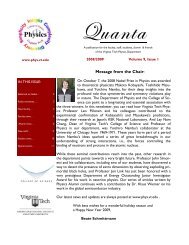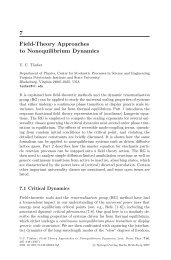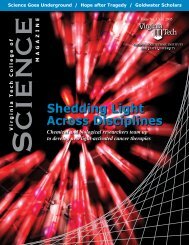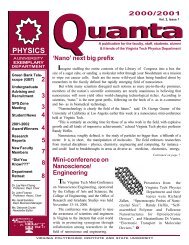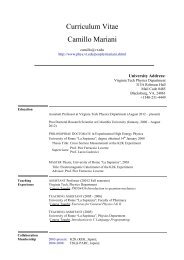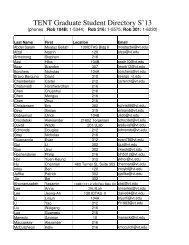CAEN V767 128 Channel Gen. Purpose MH TDC - Physics
CAEN V767 128 Channel Gen. Purpose MH TDC - Physics
CAEN V767 128 Channel Gen. Purpose MH TDC - Physics
You also want an ePaper? Increase the reach of your titles
YUMPU automatically turns print PDFs into web optimized ePapers that Google loves.
02/07/2003 <strong>V767</strong> User's Manual – Rev.4<br />
4. OPERATING CODES<br />
4.1. PROGRAMMING CAPABILITY<br />
The module programming is performed by means of an on-board microcontroller. The<br />
User sends and receives instructions and data to/from the microcontroller via 16-bit<br />
OPCODE setup words. The handshake is the following:<br />
Write Operation:<br />
• the VME (master) tests the WRITE_OK bit in the Opcode Handshake Register (see<br />
§ 3.21); if the WO bit is set to 1, the VME can write a datum;<br />
• the WO bit is automatically reset after the datum is written and is set back to 1 when<br />
the datum has been acquired by the server;<br />
• when the WO bit is set back to 1, the VME can write another datum.<br />
Read Operation;<br />
• a valid datum can be read via VME only if the READ_OK (RO) bit in the Opcode<br />
Handshake Register (see § 3.21) is set to 1;<br />
• the RO bit is automatically reset after the datum is read out and is set back to 1<br />
when a new datum is ready to be read out;<br />
• when the RO bit is set back to 1, the VME can read another datum.<br />
N.B.: because of <strong>V767</strong> module's internal delays it is necessary to insert a 10-ms<br />
delay in the software after the check of the RO/WO bit, i.e. before performing the<br />
next R/W operation on the Opcode Register.<br />
In general, three different types of operation can be performed:<br />
1. write an opcode,<br />
2. write an operand,<br />
3. read an operand.<br />
By default, at power-on or after a VME reset, the WO bit of the Handshake Register is<br />
set to 1 and the RO to 0: actually, the first operation to be performed is always the write<br />
operation of an opcode (operation of type 1).<br />
Conversely, the operation of type 2 must be always preceded by the write operation of<br />
an opcode which requires to write an operand: this is case, for example, of the opcode<br />
‘SET_WIN_WIDTH’ which requires to input the operand ‘width of the window’. Similarly,<br />
the operation of type 3 must be always preceded by a write operation of an opcode<br />
which issues a read access: actually, this makes the RO bit of the Handshake Register<br />
to be set to 1 in order to allow the following read operation. For example, the write<br />
operation of the opcode ‘READ_WIN_WIDTH’ makes the RO bit of the Handshake<br />
Register be set to 1 and in this way allows the following read operation.<br />
NPO:<br />
00001/97:<strong>V767</strong>x.MUTx/04 Page 38 of 75



